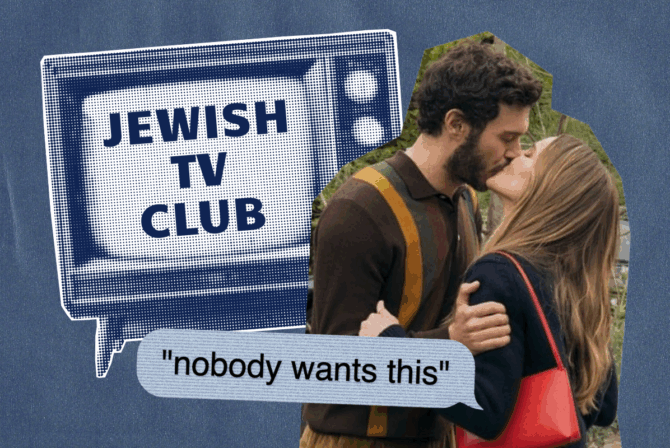Recently, my 3-year-old son came tiptoeing downstairs long after we had put him down for the night. “I can’t sleep,” he said, hugging his stuffed dog.
“Do you want a guggla-muggla?” I asked, opening the fridge and reaching for a carton of milk.
My husband snorted. “First of all, it’s ‘guggle muggle,’” he said. “Second, you make it for colds, not insomnia.”
“Says who?” I asked.
“My grandma,” he replied, definitively.
Like most discussions about Jewish food in our household, this one had its origins in our respective families, and specifically, with our grandmas.
For the uninitiated, guggla muggla (or guggle muggle, if you must) is a Jewish cold-fighting concoction of mysterious origins and disputed pronunciations and ingredients. Depending on your Bubbe, it might have been made with milk, sugar, and egg; milk and honey; or, for the unlucky, milk, tea, and schmaltz (chicken fat). My grandma made her “guggla muggla” with warm milk, honey, and vanilla. My husband’s grandma made her “guggle muggle” with egg, sugar, and milk. Hence the disagreement.
You see, my husband and I grew up with very different types of Jewish grandmas. His paternal grandma Jean (born Genya) was a Holocaust survivor from Poland, a tiny, fiercely loving, and hilarious woman who was deadly serious about food. She prided herself on her small but beloved repertoire of traditional Ashkenazic recipes, all of which she knew by heart. Every meal was an occasion, with fine silver and crystal serving dishes set out on the table. On one of my first visits to her house, she had laid out what she told us would be a “simple luncheon” consisting of blinis, mushroom and shrimp salads, an assortment of cheeses, cookies, and cheesecake. Although she didn’t eat a single bite, she made certain we all ate seconds (and thirds) of everything on the table. The more we ate, the happier she was. I learned early on that refusing second helpings was not only an insult, but a grave faux pas. Once, after I balked at eating a second homemade cookie after breakfast, she pointed a craggy finger at me and said, “I’m watching you.”
My paternal grandma Sis (born Estelle) had a markedly different upbringing. Estranged from her affluent Jewish Russian-Romanian parents at an early age, she rebelled and became a lifelong political activist and bohemian. She couldn’t stand most associations with her family, or anything that smacked of the “old world” from which they came, so she fled New York and settled in New Mexico, where she became an avid fan of the natural foods movement. She dried her own fruit, made carob milkshakes, and took me and my sister hunting for wild asparagus on the banks of the Rio Grande. She sought out any and all ethnic foods and ate everything with relish. To grandma Sis, food was also an extension of her politicized outlook on life. She abhorred waste and railed against overabundance in all its forms. She was known to dumpster dive behind grocery stores, bring doggie bags to buffets (to pack extra meals to take home with her), and eat entire meals out of the tiny plastic sample cups doled out by exasperated Whole Foods employees. At mealtimes, she would often refuse to make herself a plate of food. “I’m not hungry,” she’d say, and then proceed to eat from everybody else’s plate at the table.
For both of our grandmas, food was about more than sustenance–it was about becoming American in their own ways. For grandma Jean, food was love made visible, a triumph over the deprivation she endured during the War. It was proof that she not only survived the Holocaust, but was also going to make damn sure that future generations of her Jewish offspring were well-fed. Like generations of refugees before and after, she used food to rebuild her family in America. For grandma Sis, food was about becoming American by rejecting old culinary traditions, experimenting wildly with new ways of cooking and eating, embracing unfamiliar ethnic cuisines, and opting out of a system that equated culinary excess with wealth.
Both of our grandmas passed away before they could imprint their unique culinary heritage on our kids. For a while, both my husband and I thought we’d make a big deal about passing down the recipes we grew up with. But mostly, we find ourselves sharing the heritage of our grandmas simply by telling our kids the incredible stories of their lives. To be sure, there’s a little bit of grandma Jean in my husband and a little bit of grandma Sis in me, particularly when the holidays roll around. He makes apple cake, I roast red peppers to make the Middle Eastern dip muhummara. Our lives now are inching away from the world of old family traditions, and moving into a new world defined by adaptation, fusion, and improvisation. Although we make a few standard Ashkenazic dishes, on Shabbat and other occasions we mostly seek out new recipes from Jewish communities around the world. This feels right for our family and for the way we live now. Through our food, we’re creating new traditions, which will also certainly be adapted (and perhaps rejected) by our own children some day.
Take my own recipe for guggle muggle, which bears traces of my past and a Vermont twist in honor of my new found home:
GREENMOUNTAIN GUGGLE MUGGLE
Heat up a cup of milk in the microwave. Pour in 1 teaspoon of maple syrup and a few drops of vanilla. STIR, SERVE.
It wouldn’t pass muster with most Bubbes, but it makes for happy children.
“Mom,” my 6-year-old said to me the other day as he was sipping his drink, “when you combine ‘guggle muggle’ and ‘guggla muggla,’ you get ‘guggle muggla.’” And with that, a new Jewish-American tradition was born.
How do you reconcile different food traditions in your family?
Like this post? Get the best of Kveller delivered straight to your inbox.







